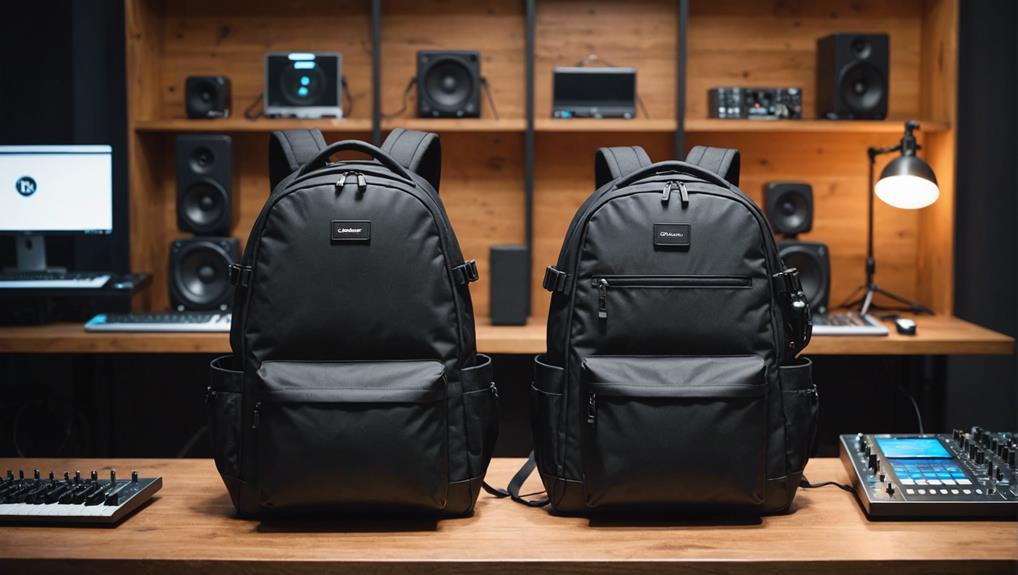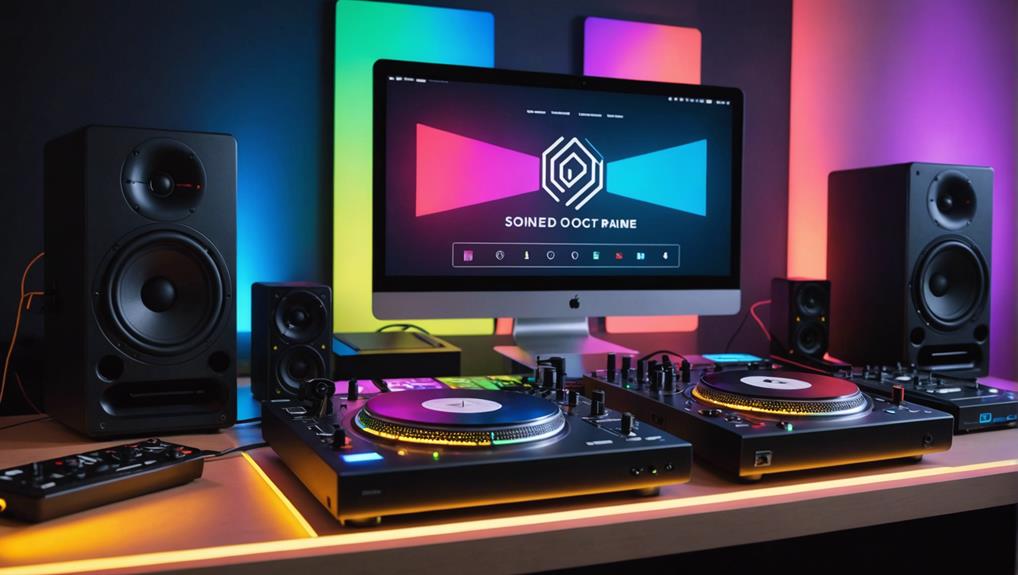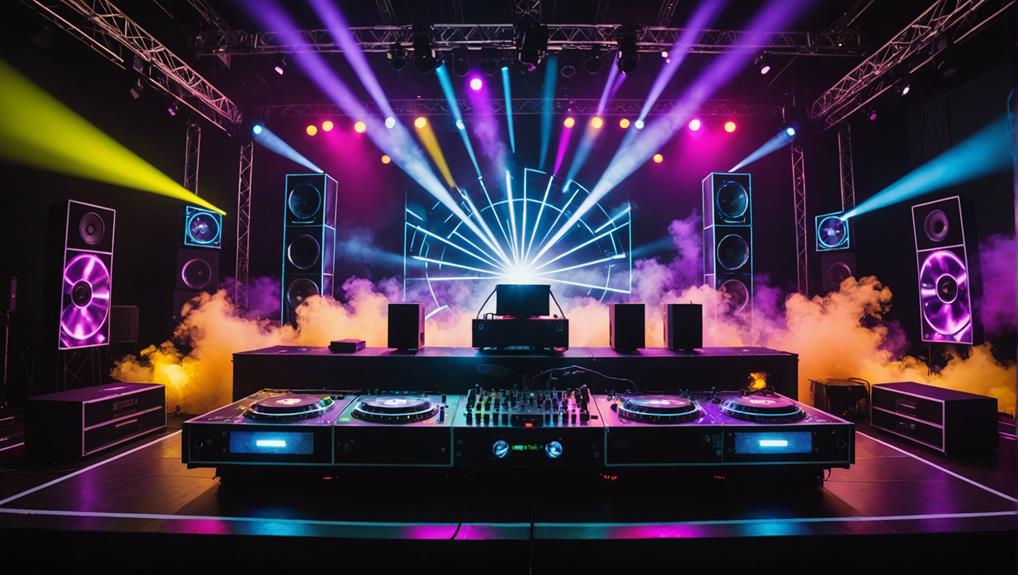No products in the cart.
To start your DJ mixing journey, first define your goals and understand various DJ roles to tailor your approach. Acquire the essential equipment such as turntables, mixers, and headphones, ensuring you choose quality gear that fits your budget. Master basic skills including beatmatching, EQing, and phrasing through consistent practice. Organize your music library effectively by BPM, genre, and mood, making track selection smoother. Record your mixes to analyze and improve your techniques. Engage actively with your audience, using feedback to enhance performances. Finally, expand your network to land gigs and build your reputation. More invaluable insights await as you explore further.
Contents
hide
Key Takeaways
- Acquire essential DJ equipment like turntables, mixers, and headphones to start mixing.
- Master basic skills including beatmatching, phrasing, and gain control through routine practice.
- Record and analyze your mixes to identify areas for improvement and enhance your technique.
- Organize your music library by BPM, genre, and key for efficient track selection during mixing.
- Engage with your audience and network to gain feedback and opportunities for live practice.
Understand DJ Roles
As a DJ, you’ll encounter various roles, each demanding specific skills and serving distinct purposes in different settings. Club DJs, for instance, focus on maintaining high energy levels, strategically selecting tracks to keep the dance floor buzzing. Here, DJ etiquette is essential; understanding the crowd and responding to their energy is paramount. Industry insights also play a key role in a club DJ’s success, as staying updated with the latest tracks and trends can set you apart.
In contrast, mobile DJs at private events like weddings or birthdays provide a more personalized experience. They often adhere to a pre-discussed playlist while still being adaptable to the vibe of the event. Here, community involvement is significant, as word-of-mouth can greatly enhance your reputation and lead to more gigs.
Radio DJs, on the other hand, curate playlists that resonate with a broader audience and often include engaging commentary. This role requires a good grasp of broadcasting etiquette and an understanding of the demographic you’re catering to.
Networking opportunities abound across all these roles. Building relationships within the DJ community can lead to valuable insights and opportunities. Engaging with fellow DJs and participating in events can foster significant growth and learning in your DJ career.
Set Your DJ Goals
As you set your DJ goals, it’s important to identify your personal objectives. Define performance milestones that reflect your desired skill level and track your progress methodically.
This approach guarantees you’re not just mixing, but you’re improving with every session.
Identify Personal Objectives
Setting clear goals will sharpen your focus and guide your efforts as you start on your DJing journey. Whether you’re aiming to master beatmatching, enhance your progression skills, or explore various music genres, defining these objectives is essential. By identifying your personal targets, you’re not just dreaming; you’re planning.
Implementing effective goal tracking and progress monitoring mechanisms will play a vital role in your development. These tools help you see where you’re advancing or where you need more practice, keeping your motivation high. Remember, your goals might change as you evolve, which is a natural part of growing as a DJ. Stay flexible, but always keep your targets in sight to measure your successes accurately.
Define Performance Milestones
Now that you’ve identified your personal objectives, it’s time to define specific performance milestones to effectively measure your progress and maintain motivation as you enhance your DJ skills.
Setting progress markers such as mastering basic mixing techniques, performing at a local event, or recording a mixtape helps in tracking improvement methodically. These milestones are essential for focusing your practice sessions and guiding your efforts towards continual skill enhancement.
As you achieve each goal, celebrating achievements boosts your confidence and fuels your desire to progress further. Whether you’re learning advanced techniques or aiming for a residency gig, staying motivated through clear and achievable goals is critical to advancing your DJ career.
Choose DJ Software
Choosing the right DJ software is important as you start on your mixing journey. You’ll need to compare the features of popular options like Serato DJ, Traktor, and Rekordbox to find the one that matches your needs regarding usability and functionality.
Additionally, consider your budget to make sure you’re investing wisely in software that supports your DJ goals without overstretching your finances.
Popular DJ Software Options
Selecting the right DJ software is essential, as it serves as the backbone of your mixing setup. When choosing, consider software compatibility and hardware integration to guarantee smooth operation. Look for features that allow interface customization and effects exploration, which can greatly enhance your creative potential.
| Software | Compatibility & Integration | Customization & Effects |
|---|---|---|
| Serato DJ | Excellent with varied DJ hardware | User-friendly interface |
| Traktor Pro | Advanced MIDI mapping | Extensive effects, remix decks |
| Virtual DJ | Supports multiple platforms | Large effects library |
| Rekordbox | Optimized for Pioneer DJ gear | Efficient track management |
Each option offers unique tools and functions, shaping how you mix and perform.
Software Features Comparison
To make an informed decision on DJ software, compare the distinctive features and capabilities each offers.
Serato DJ’s user-friendly interface and robust library management make it a top choice for beginners seeking ease of use with powerful functionality.
Traktor Pro steps up with its advanced Remix and Stem Decks, ideal for DJs looking to creatively manipulate tracks live.
Virtual DJ is your go-to for video mixing and boasts an extensive effects library, accommodating a broad range of controllers.
Meanwhile, Ableton Live shines in live performance flexibility with its session view and extensive MIDI mapping.
Finally, Rekordbox offers unparalleled integration with Pioneer DJ hardware and excels in track analysis for precise beatmatching.
This comparison breakdown and software feature highlights guide you toward the right choice.
Budgeting for DJ Software
When budgeting for DJ software, you’ll want to take into account both the upfront costs and the potential ongoing subscription fees. Here’s a software pricing comparison to help you identify budget-friendly options:
| Software | Pricing Options |
|---|---|
| Serato DJ | $9.99/month or $129 one-time |
| Traktor Pro 3 | $99 one-time |
| Virtual DJ | Free limited, From $19/month |
| Ableton Live | $16.50/month or $449 one-time |
| Rekordbox | $129 for DJ, $99 for DVS |
Consider these options carefully to find a solution that balances cost with features, ensuring you get the most value for your investment in DJing.
Master Basic Skills
Mastering essential skills like beatmatching, phrasing, and gain control is important for achieving smooth changes in your DJ mixes. You’ll need to establish practice routines that focus specifically on these techniques. Regularly schedule sessions where you concentrate on syncing beats manually, without relying on software to do it for you. This strengthens your ear and enhances your ability to match tracks intuitively.
Incorporating effective equipment maintenance into your routine guarantees your gear performs at its best, preventing any technical hitches during practice. Clean your equipment regularly, check connections, and update software to avoid glitches that could interrupt your flow.
Next, explore understanding EQing techniques. Balancing frequencies is essential; it prevents sound clashes and ensures a smooth shift between tracks. Practice adjusting low, mid, and high frequencies to see how they affect the overall mix.
Recording your mixes is another valuable practice. Listen back to identify any issues with your shifts or EQ settings. This analysis helps you pinpoint areas needing improvement.
Lastly, experiment with different genres and tempos. This versatility isn’t just about keeping your sets interesting; it’s a practical way to adapt to any crowd or venue, ensuring your skills are well-rounded and adaptable.
Acquire DJ Equipment
Before diving into DJ mixing, you’ll need to equip yourself with essential DJ gear, including turntables, controllers, mixers, headphones, and speakers. Choosing the right equipment hinges on your budget, preferences, and the specific style of DJing you wish to pursue. Quality gear is vital for ensuring a smooth and enjoyable mixing experience, so it’s worth investing time in researching and selecting the best options for your needs.
For beginners, starting with an entry-level controller might be the most practical choice. These devices offer a good balance between functionality and affordability, allowing you to hone your skills without a massive initial investment. Also, consider the second-hand market for scoring deals on high-quality equipment at lower prices. This approach can be particularly advantageous if you’re budget-conscious but unwilling to compromise on quality.
Additionally, maintaining your equipment is essential for its longevity and performance. Regularly clean your gear, check cables and connections, and store everything properly to avoid damage. Seeking advice from experienced DJs can also provide valuable insights into both the selection and care of your DJ equipment, ensuring you make informed decisions that will benefit your DJ journey.
Record Your Mixes
When you record your mixes, you’re setting up a framework to critically analyze your mixing techniques and the smoothness of your connections.
By listening back, you’ll pinpoint exactly what’s working and what isn’t, allowing for targeted improvements in your DJ skills.
This ongoing process not only enhances your technical abilities but also helps you develop a more refined and cohesive sound.
Analyze Mixing Techniques
Recording your mixes provides a critical opportunity to analyze blends, track selections, and the overall flow, enabling you to identify and refine areas that need improvement. Engaging in mix analysis is essential; by reviewing your recordings, you’ll precisely understand how well elements like beatmatching and energy levels are maintained throughout your set. Pay special attention to your shift critique. This evaluation isn’t just about noticing abrupt changes or off-beat mixes, but also about recognizing where the shifts enhance or disrupt the musical journey.
Critically listening to your mixes helps you identify subtle nuances and areas needing enhancement. It’s this level of detailed analysis that transforms a novice into a proficient DJ, adept at crafting seamless musical experiences.
Improve Transition Smoothness
To enhance the smoothness of your progressions, start by recording your mixes to pinpoint areas for refinement. By listening back, you’ll understand how different tracks blend and where you need to adjust. This practice routine is essential for mastering shift techniques.
Focus on the nuances of beat matching and track selection, as these are pivotal for seamless shifts. Each recording session should be a deliberate part of your practice, aiming to improve specific elements of your mixing. As you record more, you’ll notice incremental improvements, helping you evolve into a more skilled DJ.
Additionally, these recordings can double as a portfolio, showcasing your growing capabilities to potential clients or audiences.
Build Your Audience
Developing your audience is essential as you improve your skills and broaden your reach as a DJ. One effective method is to actively engage with your audience during your sets. This can be done through shoutouts, taking song requests, and creating interactive moments that invite your audience to participate in the experience. These strategies not only build a connection but also enhance audience enjoyment and retention.
Additionally, leverage social media platforms to extend your engagement beyond live performances. Regular posts, behind-the-scenes content, and updates about your DJing journey can keep your audience connected and involved. It’s also a great space for fan interaction. Respond to comments, host live sessions, and share exclusive content. This direct engagement makes your followers feel valued and more invested in your success.
To further entice and retain your audience, offer exclusive content or special perks. These could include early access to your new mixes, discounts on merchandise, or exclusive digital content. Pay close attention to audience feedback and insights from these interactions to tailor your performances and content to better suit their preferences, ensuring they remain engaged and excited about your work.
Land Your First Gigs
Landing your first DJ gig requires you to actively approach local bars, clubs, and venues that resonate with your music style. This step is important not only for gig opportunities but also for networking, which can greatly influence your early career. It’s also your chance to start building a reputation and to gain valuable exposure opportunities that are essential for your skill development.
Here are some targeted actions to help you break into the scene:
- Showcase Your Talent: Participate in DJ contests and open deck nights. These events are perfect for gaining exposure and showing off your skills to a crowd that includes potential employers and industry insiders.
- Network Relentlessly: Attend local music events, industry meetups, and clubs. Introduce yourself to promoters, fellow DJs, and venue owners. The connections you make can lead to unexpected gig opportunities and collaborations.
- Prepare a Professional Press Kit: Include a compelling bio, professional photos, samples of your mixes, and contact information. This kit represents you in your absence and is a critical tool when approaching venues or responding to gig inquiries.
Improve Your Techniques
As you enhance your DJ skills, mastering various techniques is essential for creating seamless and engaging mixes. Focusing on a few key areas can significantly improve your performance. Here’s a breakdown to guide your practice sessions:
| Technique | How to Practice |
|---|---|
| Beatmatching | Align the BPMs of two tracks, using your ears to make sure they’re in sync. |
| EQing | Adjust bass, midrange, and treble levels to blend tracks smoothly. |
| Phrasing | Mix at ideal points, such as during breakdowns or build-ups. |
| Scratching | Start with basic scratches, incorporating them creatively into your mixes. |
| Gain Control | Manage the volume of each track to maintain balanced sound. |
Incorporate mixing drills in your daily routine, focusing on these techniques. Pay attention to track selection and how the crowd reacts; this interaction is vital. Remember, each session is an opportunity to refine your craft. Stick to these performance tips and observe how your mixes improve, making you more confident in handling any live situation.
Expand Your Music Library
To enhance your DJ performances, it’s essential to consistently grow your music library, catering to a diverse range of tastes and occasions. Music discovery is vital in this process, and online resources are your best allies. Utilizing streaming services like Spotify, Apple Music, and TIDAL provides access to an extensive array of tracks that you can experiment with in your mixes. Additionally, staying updated with new releases and industry trends guarantees your sets remain fresh and engaging.
Here’s how you can effectively expand your music library:
- Diversify Your Collection: Invest in a variety of music genres. This not only enhances your flexibility in playing for different audiences but also broadens your own musical horizons. Genre exploration can lead you to unexpected favorites and solidify your reputation as a versatile DJ.
- Utilize Playlists: Create playlists for different moods and occasions—high-energy dance sets, relaxed background tunes, etc. This organization simplifies finding the right track during live performances and helps in building a coherent set.
- Follow Artist Recommendations: Keep an eye on artist recommendations and curated lists within your streaming services. These can be a goldmine for discovering new tracks and emerging artists, enriching your music library with fresh sounds that might captivate your audience.
Frequently Asked Questions
What Should a Beginner DJ Practice?
You should focus on equipment setup and mastering beat matching. Practice aligning beats to guarantee smooth shifts. This foundational skill is vital for your development as a DJ and enhances your live performances.
What Are the Fundamentals of DJ Mixing?
The fundamentals of DJ mixing include mastering beat matching and track selection. You’ll need to sync BPMs accurately and choose tracks that complement each other to guarantee seamless, engaging shifts.
How Do You Prepare for a DJ Mix?
To prepare for a DJ mix, start with careful track selection to guarantee diverse tempos and genres. Then, set up your equipment properly, checking all connections and settings on your mixer and decks.
How Do I Make My First DJ Mix?
To make your first DJ mix, you’ll need to focus on equipment selection and music sourcing. Choose compatible gear and gather tracks that match your chosen style for a seamless, dynamic set.




